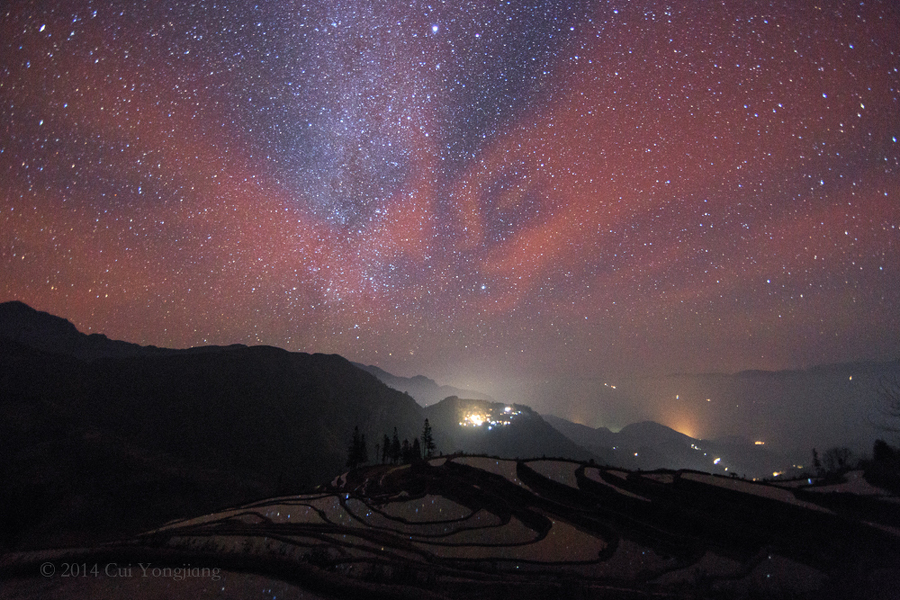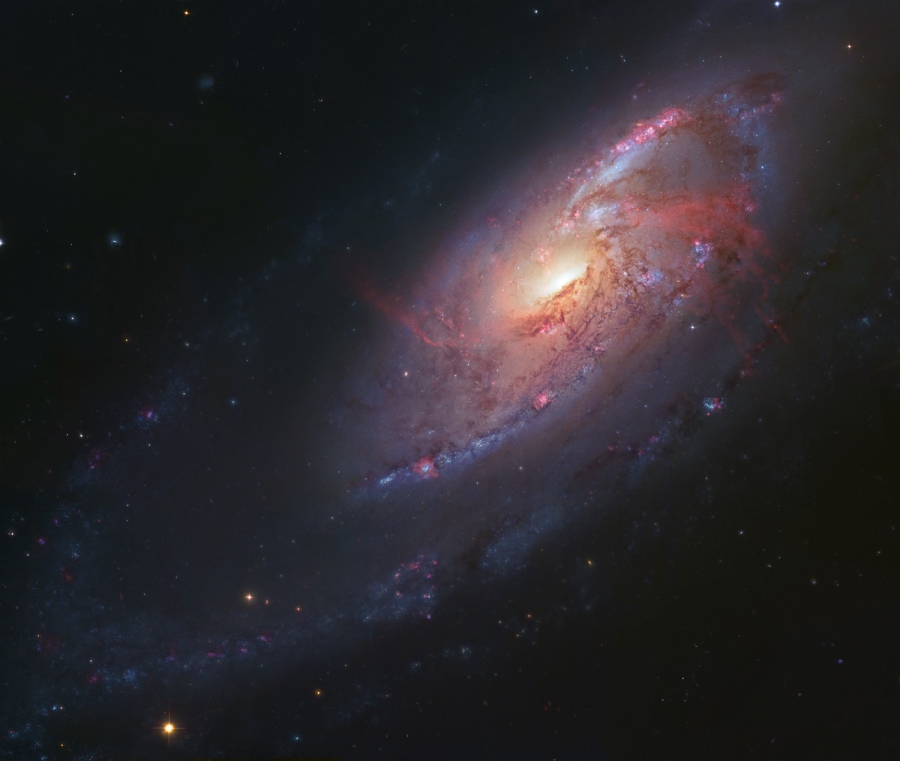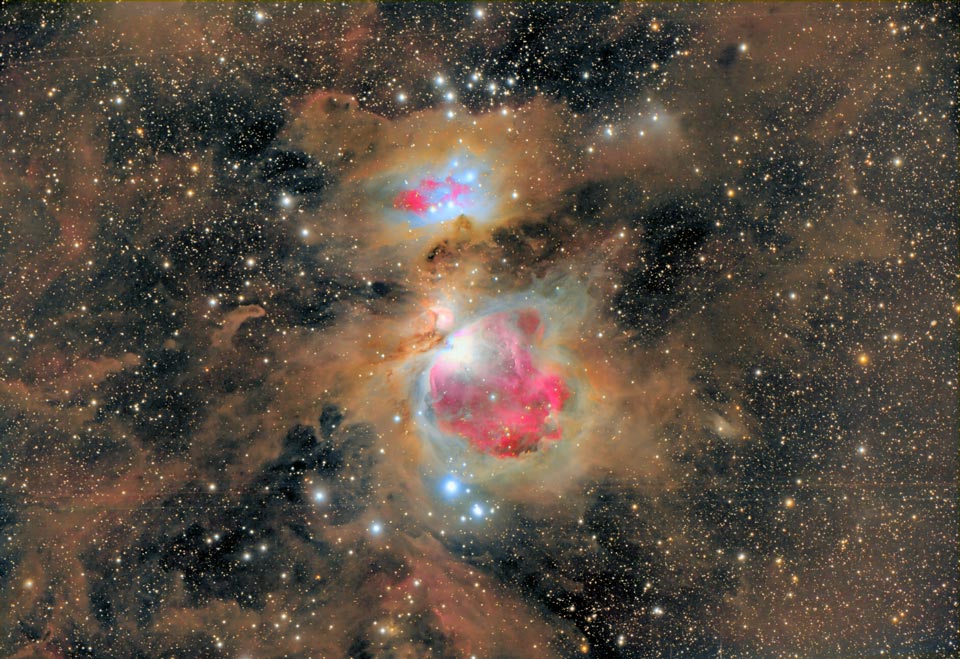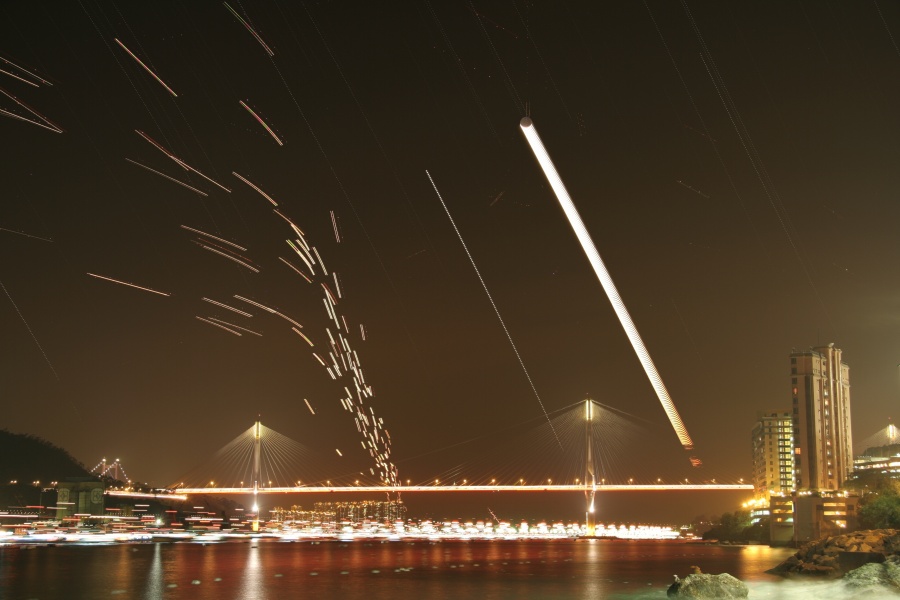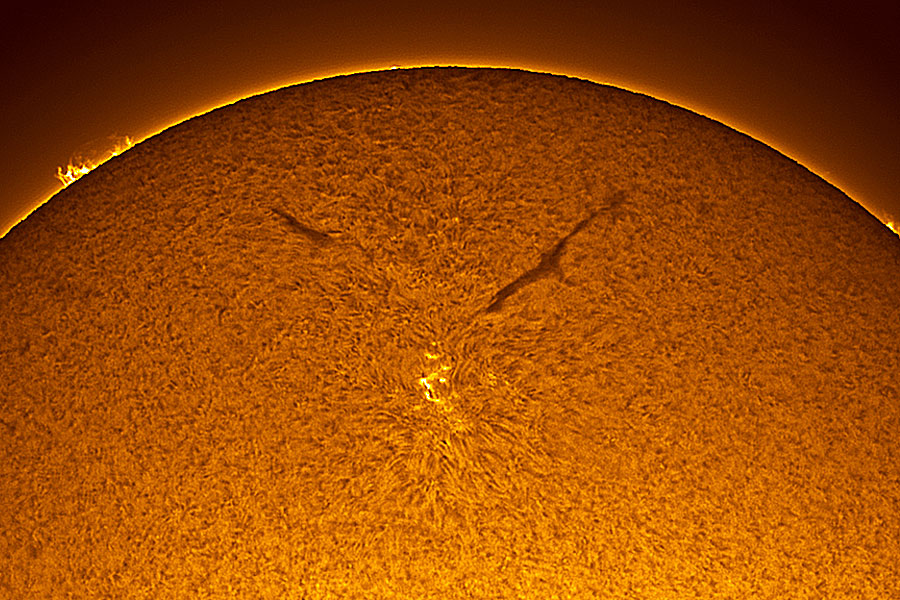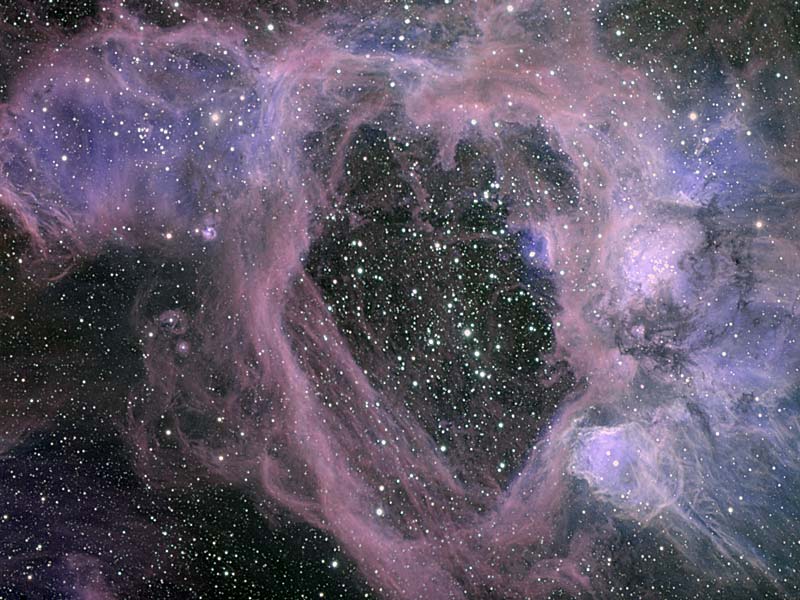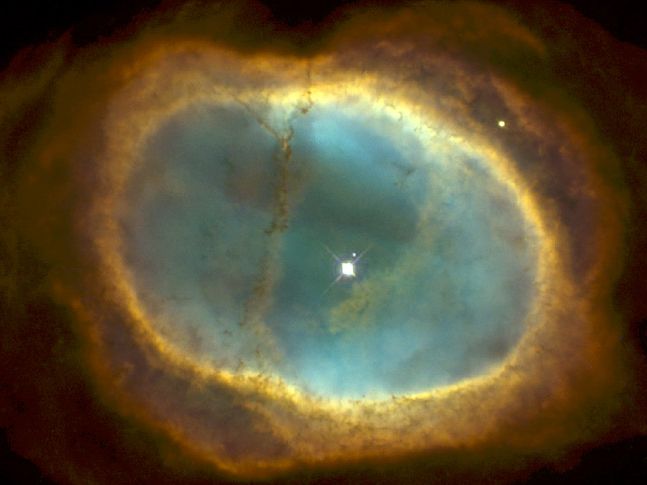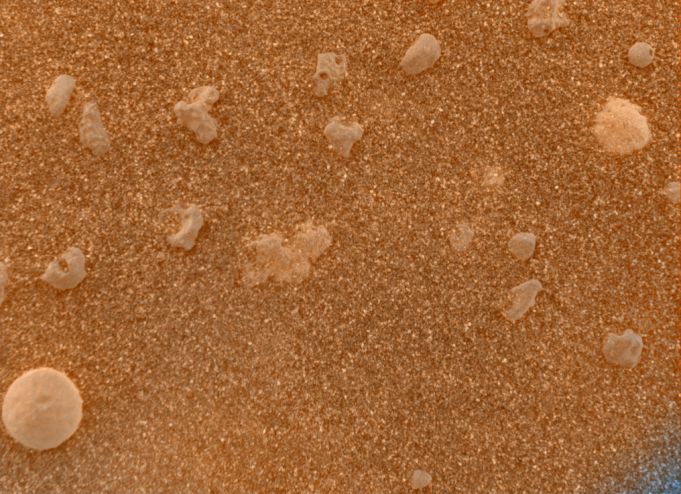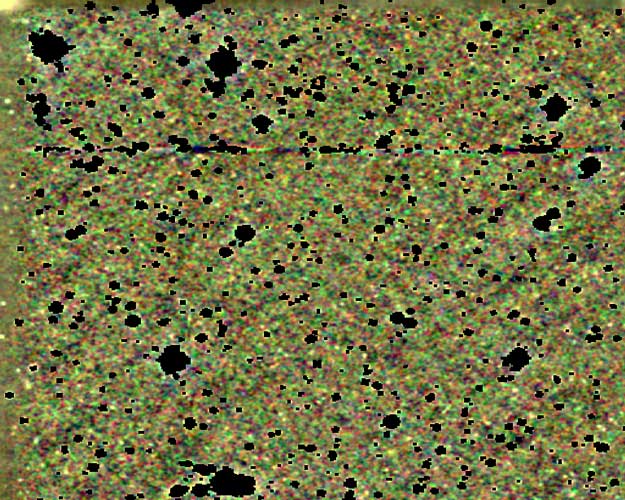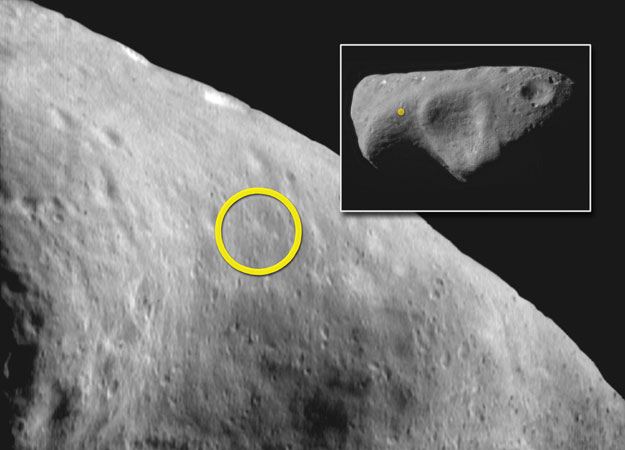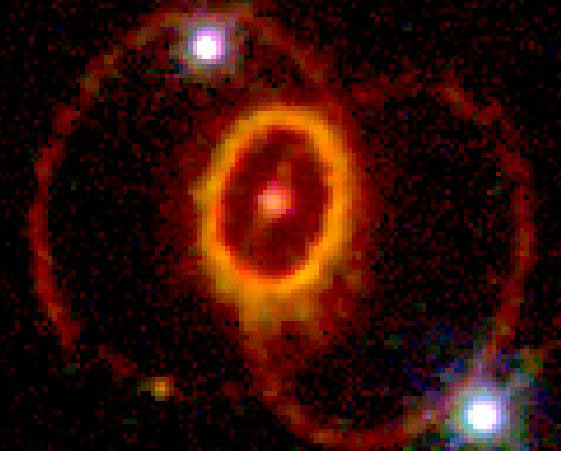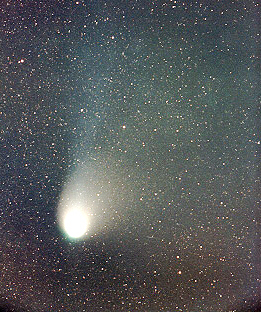| << Previous | Index | Next >> |
2015 Our solar system's ruling giant planet Jupiter and 3 of its 4 large Galilean moons are captured in this single Hubble snapshot from January 24. Crossing in front of Jupiter's banded cloud tops Europa, Callisto, and Io are framed from lower left to upper right in a rare triple-moon conjunction. Distinguishable by colors alone icy Europa is almost white, Callisto's ancient cratered surface looks dark brown, and volcanic Io appears yellowish. The transiting moons and moon shadows can be identified by sliding your cursor over the image, or following this link. Remarkably, two small, inner Jovian moons, Amalthea and Thebe, along with their shadows, can also be found in the sharp Hubble view. The Galilean moons have diameters of 3,000 to 5,000 kilometers or so, comparable in size to Earth's moon. But odd-shaped Amalthea and Thebe are only about 260 and 100 kilometers across respectively.
2014 Long after sunset on January 25 an unusually intense red airglow floods this south-looking skyscape. The scene was recorded with a long exposure using a digital camera over Yunnan Province in southwest China. At best faintly visible to the eye, the lingering airglow is due to chemiluminescence, the production of light through chemical excitation. Originating at an altitude similar to aurora, it can found around the globe. The chemical energy is initially provided by the Sun's extreme ultraviolet radiation On this night, despite the luminous atmosphere, the band of the Milky Way clearly stretches above the horizon with bright star Sirius near the top of the frame. Both airglow and starry sky are beautifully reflected in region's watery Yuanyang rice terraces below.
2013 The spiral arms of bright galaxy M106 sprawl through this remarkable multiframe portrait, composed of data from ground- and space-based telescopes. Also known as NGC 4258, M106 can be found toward the northern constellation Canes Venatici. The well-measured distance to M106 is 23.5 million light-years, making this cosmic scene about 80,000 light-years across. Typical in grand spiral galaxies, dark dust lanes, youthful blue star clusters, and pinkish star forming regions trace spiral arms that converge on the bright nucleus of older yellowish stars. But this detailed composite reveals hints of two anomalous arms that don't align with the more familiar tracers. Seen here in red hues, sweeping filaments of glowing hydrogen gas seem to rise from the central region of M106, evidence of energetic jets of material blasting into the galaxy's disk. The jets are likely powered by matter falling into a massive central black hole.
2012 What surrounds a hotbed of star formation? In the case of the Orion Nebula -- dust. The entire Orion field, located about 1600 light years away, is inundated with intricate and picturesque filaments of dust. Opaque to visible light, dust is created in the outer atmosphere of massive cool stars and expelled by a strong outer wind of particles. The Trapezium and other forming star clusters are embedded in the nebula. The intricate filaments of dust surrounding M42 and M43 appear brown in the above image, while central glowing gas is highlighted in red. Over the next few million years much of Orion's dust will be slowly destroyed by the very stars now being formed, or dispersed into the Galaxy.
2011 No one knows for sure what caused this signal. There is a slight possibility that it just might originate from an extraterrestrial intelligence. The bright colors on the blue background indicate that an anomalous signal was received here on Earth by a radio telescope involved in a Search for Extraterrestrial Intelligence (SETI). A search for these signals is ongoing by several groups including volunteer members of the SETI League. Time labels the vertical axis of the above plot, and frequency marks the horizontal axis. Although this strong signal was never positively identified, astronomers have identified in it many attributes characteristic of a more mundane and ultimately terrestrial origin. In this case, a leading possibility is that the signal originates from an unusual modulation between a GPS satellite and an unidentified Earth-based source. Many unusual signals from space remain unidentified. No signal has yet been strong enough or run long enough to be unambiguously identified as originating from an extraterrestrial intelligence.
2010 This remarkable scene combines multiple exposures recorded on the evening of January 18th from a waterside perspective in Hong Kong, China. It follows a young crescent Moon, with brilliant planet Jupiter to its left, as they set together in the western sky. Their two luminous trails are faintly paralleled by trails of background stars. But easier to pick out are the short, bright airplane trails converging toward the horizon and the Hong Kong International Airport that seem to offer a frenzied imitation of the celestial tracks. Of course, the reflection of city lights and boat traffic follows the water's surface. Streaking car lights define the span of the cable-stayed Ting Kau bridge.
2009 On February 2nd, a first quarter Moon shone in planet Earth's early evening sky. As seen from a location on the US west coast near Mt. Hamilton, California, the International Space Station also arched above the horizon, crossing in front of the Moon's sunlit surface. The space station's transit lasted 0.49 seconds. This sharp exposure, a well-timed telescopic image, recorded the space station during the transit against the background of the Moon's smooth Mare Serenitatis (Sea of Serenity). The orbital outpost was traveling northwest to southeast (from 2 o'clock to 8 o'clock) at a range of 389 kilometers or about 230 miles. Of course, the Moon itself was 1,000 times farther away. In the remarkable photo, the glinting station also offers a hint of the bluish reflection of earthlight.
2008 A new cycle has begun on our Sun. Over the past year, the Sun's magnetic field has reset and now a new 11 year period is beginning. Pictured above in a specific color of light emitted by hydrogen is sunspot 10982, one of the last sunspots of the old solar cycle. The two dark lines visible just above and to either side of the bright sunspot are cool filaments held aloft by the Sun's magnetic field. Hot and cold regions are shown as regions of relative light and dark, respectively. A solar cycle is caused by the changing magnetic field, and varies from solar maximum, when sunspot, coronal mass ejection, and flare phenomena are most frequent, to solar minimum, when such activity is relatively infrequent. Solar minimums occurred in 1996 and 2007, while the last solar maximum occurred in 2001.
Editor's note: This APOD originally ran under the title "A Sunspot in the New Solar Cycle." But even though the new solar cycle has begun, the old one has not ended yet and may run concurrently with the new cycle for up to a year or so. This sunspot is now thought to belong to the old cycle, not the new one, based on its measured magnetic polarity and location.
2007 What's happening to our Sun? Another Coronal Mass Ejection (CME)! The Sun-orbiting SOHO spacecraft has imaged many erupting filaments lifting off the active solar surface and blasting enormous bubbles of magnetic plasma into space. Direct light from the sun is blocked in the inner part of the above image, taken in 2002, and replaced by a simultaneous image of the Sun in ultraviolet light. The field of view extends over two million kilometers from the solar surface. While hints of these explosive events, called coronal mass ejections or CMEs, were discovered by spacecraft in the early 70s, this dramatic image is part of a detailed record of this CME's development from the presently operating SOHO spacecraft. Near the minimum of the solar activity cycle CMEs occur about once a week, but near solar maximum rates of two or more per day are typical. Strong CMEs may profoundly influence space weather. Those directed toward our planet can have serious effects.
2006 What created this gigantic hole? The vast emission nebula N44 in our neighboring galaxy the Large Magellanic Cloud has a large, 250 light-year hole and astronomers are trying to figure out why. One possibility is particle winds expelled by massive stars in the bubble's interior that are pushing out the glowing gas. This answer has been recently found to be inconsistent with measured wind velocities, however. Another possibility is that the expanding shells of old supernovas have sculpted the unusual space cavern. An unexpected clue of hot X-ray emitting gas was recently been detected escaping the N44 superbubble. The above image, here digitally sharpened, was taken in three very specific colors by the huge 8-meter Gemini South Telescope on Cerro Pachon in Chile.
2005 It's the dim star, not the bright one, near the center of NGC 3132 that created this odd but beautiful planetary nebula. Nicknamed the Eight-Burst Nebula and the Southern Ring Nebula, the glowing gas originated in the outer layers of a star like our Sun. In this representative color picture, the hot blue pool of light seen surrounding this binary system is energized by the hot surface of the faint star. Although photographed to explore unusual symmetries, it's the asymmetries that help make this planetary nebula so intriguing. Neither the unusual shape of the surrounding cooler shell nor the structure and placements of the cool filamentary dust lanes running across NGC 3132 are well understood.
2004 At first glance, this sharp, color close-up gives the strong impression of pebbles strewn over a sandy beach. But the picture is one of the first microscopic images of another planet, captured by the Opportunity rover on its tenth sol on the martian surface at Meridiani Planum. The patch of soil measures about 3 centimeters (1.2 inches) across. It is shown in shades approximating what the eye might see, obtained by combining pictures of the soil with and without the microscopic imager's orange-tinted dust cover in place. Searching for evidence of past water on Mars, researchers note that both volcanic and water-related accretion processes could have produced the striking circular grain at the lower left. However, other investigations now indicate the soil near the lander contains olivine, an iron-bearing mineral common in volcanic rocks, while a signature of the iron mineral hematite was found in soil around a nearby rocky outcrop. On planet Earth, hematite often forms in association with liquid water.
2003 Bright and beautiful spiral galaxy M83 lies a mere twelve million light-years from Earth, toward the headstrong constellation Hydra. Sweeping spiral arms, prominent in visible light images, lend this galaxy its popular moniker -- the Southern Pinwheel. In fact, the spiral arms are still apparent in this Chandra Observatory false-color x-ray image of M83, traced by diffuse, hot, x-ray emitting gas. But more striking in the x-ray image is the galaxy's bright central region. The central emission likely represents even hotter gas created by a sudden burst of massive star formation. Point-like neutron star and black hole x-ray sources, final stages in the life cycles of massive stars, also show a concentration near the center of M83 and offer further evidence for a burst of star formation at this galaxy's core. Light from this burst of star formation would have first reached Earth some 20 million years ago.
2002 What cosmic wallpaper is on the sky? The answer depends on the type of light considered, and for some wavelengths, all the cluttering material in the foreground makes it still unknown. Recently, however, the background in near infrared light was imaged at high resolution by the 2MASS telescope, and confirmed earlier estimates that it is over twice as bright as originally expected. A small section of Cosmic Infrared Background (CIB) is shown above in representative colors. Visible is light emitted from the very first stars and galaxies in the universe, emitted when the universe was less than half its current age. The CIB is more uniform than the present universe since stars were more spread out at early times. The brightness of the background indicates that many stars were forming in the universe between cosmological redshifts of one and seven.
2001 The first controlled descent of a spacecraft onto an asteroid is scheduled to occur next week. The robot spacecraft NEAR-Shoemaker has been orbiting asteroid Eros for nearly one year On February 12, before maneuvering fuel wanes, NASA will command the craft to descend right down onto the surface. Although the spacecraft is not expected to survive the impact, it is hoped that it can transmit photographs showing surface details as small as 10 centimeters during the descent. The touchdown site, shown above by the yellow circle, is on the edge of the large saddle shaped feature known as Himeros, and near the boundary between two distinct types of surface terrain.
2000 What's causing those odd rings in supernova 1987A? In 1987, the brightest supernova in recent history occurred in the Large Magellanic Clouds. At the center of the picture is an object central to the remains of the violent stellar explosion. When the Hubble Space Telescope was pointed at the supernova remnant in 1994, however, the existence of curious rings was confirmed. The origins of these rings still remains a mystery. Speculation into the cause of the rings includes beamed jets emanating from a dense star left over from the supernova, and a superposition of two stellar winds ionized by the supernova explosion. Meanwhile, astronomers have just reported the possible appearance of a new ring feature.
1999 The first US spacecraft was Explorer 1. The cylindrical 30 pound satellite was launched (above) as the fourth stage of a Jupiter-C rocket (a modified US Army Redstone ballistic missile) and achieved orbit on January 31, 1958. Explorer I carried instrumentation to measure internal and external temperatures, micrometeorite impacts, and an experiment designed by James A. Van Allen to measure the density of electrons and ions in space. The measurements made by Van Allen's experiment led to an unexpected and startling discovery -- an earth-encircling belt of high energy electrons and ions trapped in the magnetosphere now known as the Van Allen Belt. Explorer I ceased transmitting on February 28 of that year but remained in orbit until March of 1970.
1998 Sunday marks the 170th anniversary of the birth of Jules Verne (born in Nantes, France on the 8th of February, 1828). Inspired by a lifelong fascination with machines, Verne wrote visionary works about "Extraordinary Voyages" including such terrestrial travels as Around the World in 80 Days, Journey to the Centre of the Earth, and Twenty Thousand Leagues Under the Sea. In 1865 he published the story of three adventurers who undertook a journey From the Earth to the Moon. Verne's characters rode a "projectile-vehicle" fired from a huge cannon constructed in Florida. Does that sound familiar? A century later, the Saturn V rocket and NASA's Apollo program finally turned this work of fiction into fact, propelling adventuresome trios on what was perhaps Verne's most extraordinary voyage. This stirring floodlit view shows the Apollo 9 space-vehicle atop its Saturn V. Launched from a spaceport in Florida in 1969, the Apollo 9 crew were the first to test all lunar landing hardware in space .
1997 Comet Hale-Bopp has returned from behind the Sun. In December and early January, Comet Hale-Bopp was too near the Sun to be easily visible from Earth. Now the comet graces the morning sky and is visible from dark locations even without binoculars. The above photo was taken on January 31st and shows the two emerging tails of Comet Hale-Bopp. The blue wisp pointing up is the ion tale, while the white fuzz is the dust tail. On its trip to the inner Solar System, Comet Hale-Bopp is once again showing signs it could brighten in the next few months to become the most spectacular comet in modern times.
1996 Above are two microwave images of the sky, looking north and south of our galaxy's equator, based on data from NASA's COBE satellite. After computer processing to remove contributions from nearby objects and the effects of the earth's motion, they show "spots". These spots are the oldest structures known - probably the oldest structures humanity will ever know. They are also the most distant. As our universe expanded and cooled, conglomerations of mass formed - these are some of the first. They confirm that only a million years after the big-bang - which occurred roughly 15 billion years ago - parts of the universe were visibly hotter than other parts. By studying the size and distribution of the spots found with COBE and future missions, astronomers hope to learn what matter and processes caused the spots to form - and hence determine the composition, density, and future of our universe.
| << Previous | Index | Next >> |

